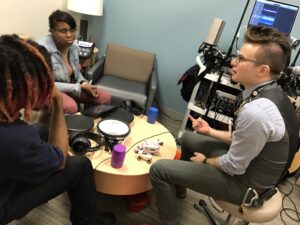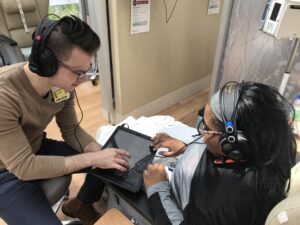This month, as we continue our series on complementary therapies, Sick Cells spoke with Sam Rodgers-Melnick, MT-BC, a music therapist and clinical researcher at University Hospitals Connor Integrative Health Network in Cleveland, OH. Sam primarily works with adults living with sickle cell. Sam discusses his day-to-day work, the importance of building trust with patients, and his plans for the future of music therapy.

Interview completed by Sick Cells Content Specialist, Amanda Vassall
Sick Cells: Hi Sam — thanks for taking the time to speak with us. We’re excited to hear more about your work with the sickle cell disease (SCD) community as a music therapist. Can you tell us more about how you got started in music therapy?
Samuel: I grew up as a musician; a percussionist who played in churches. I knew I wanted to help people. So once I finished high school, music therapy felt like a natural career path for me. I started as an intern at University Hospitals of Cleveland which later turned into a full-time career I’ve continued for the last eight years.
Sick Cells: It’s great that you’ve found a passion in music therapy. Can you tell us more about your approach to a music therapy session? What does your day-to-day work look like?
Samuel: As one of the hospital’s music therapists, I collaborate with healthcare teams to understand which patients have the highest need for sessions. Since I’ve worked at the hospital for several years, I see many patients over several admissions, but I approach each music therapy session very strategically. I spend time studying patients’ electronic medical records to assess their pain, understand their psychosocial situation, and determine how I can best help them.
Once it comes time to meet with patients, I make sure my sessions are as positive and productive as possible. This starts by entering a patient’s room and aiming to quickly shift the dynamic to build trust.
Sick Cells: We spoke with another music therapist for our complimentary therapy series who also discussed the importance of building trust with session participants. This is clearly an important element of successful sessions. How do you approach building trust?
Samuel: Quickly building rapport with participants means being my authentic self. When I walk into a room, I always sit down and listen before diving into the session. It’s about meeting patients where they are. I’ve also learned various red flags to avoid when it comes to communicating with individuals with SCD. That means knowing what to listen for and what to validate when speaking with those in my therapy sessions. Once we’re further along in the session, I assess stress, pain, and anxiety levels, ask about how they’re coping and what’s helped them cope in the past.
Sick Cells: Can you share more about a typical session? What are some key takeaways you’ve learned over the course of your time at the hospital?
Samuel: Never assume you know what type of music a participant likes. There are several different subgenres and musical textures within hip-hop, R&B, and the other musical genres patients find helpful for pain. As a music therapist, you have to be curious about what they like and what type of music they want to create. During a session, I use GarageBand or a keyboard with no wrong notes to help engage the patient in the music making process. The research we have conducted so far indicates that actively engaging a person with SCD in making music is more effective for managing pain than just listening to music.
Sick Cells: Do you find that there are common song themes in the SCD community?
Samuel: Strength, hope, resilience, and not letting sickle cell be a defining characteristic in life. Many songs also help patients process negative experiences that have to do with sickle cell care.
Sick Cells: Is there anything else you’d like to share about your experience as a music therapist working with the SCD community?

Samuel: My ultimate goal is to use music therapy to not only improve pain management and quality of life, but also address some of the challenges in patients’ healthcare. For example, when adolescents move to adult care, I can use music therapy to teach self-management skills such as understanding their lab values, organizing a pillbox, and communicating with their care team.
Music therapy is one strategy in the midst of many tools that can work but they need to be more accessible. I’ve learned that the SCD community has a willingness to engage with music therapy; there’s a natural connection to music but you have to do the work of adapting your music to the patient’s preferences and building rapport with the patient over time.
Sometimes you have to be really persistent in building relationships with participants. It may take several sessions. And while the sessions can be fun and engaging for patients, music therapy sessions can also involve processing patients’ stressors, challenges, and frustrations. It takes the right combination of musical and therapeutic skills to care for the needs of individuals with SCD.